Biology Unit 3: Cell Reproduction & Molecular Biology
1/92
There's no tags or description
Looks like no tags are added yet.
Name | Mastery | Learn | Test | Matching | Spaced |
|---|
No study sessions yet.
93 Terms
What are the 3 types of cell division?
depends on type of cell; 3 types are: binary fission (prokaryotic), mitosis (eukaryotic), and meiosis (eukaryotic; not all eukaryotes do this); mitosis & meiosis are means of cell reproduction
What are the two types of reproduction?
asexual and sexual reproduction
Asexual Reproduction
aka cell division; reproduction of an organism in which one original organism makes an identical copy of itself; includes binary fission and mitosis
Sexual Reproduction
aka reproduction; reproduction of an organism by combining genetic material from 2 diff individuals of different sexes
Binary Fission
type of asexual reproduction; cell division in prokaryotic cells; produces identical offspring in asexual organisms; cell grows so it can split; has 5 steps
What are the 5 steps of binary fission?
circular DNA is replicated; a new cell membrane is added; cell membrane pushes inward as new material is added; a new cell wall forms around membrane; dividing organism is split into 2 identical cells
Cell Division
asexual reproduction; process where cellular & genetic material from one parent cell is divided between 2 daughter cells; daughter cells have own nucleus and immediately begin own cell cycles; makes more cells within an individual; 4 purposes in eukaryotes: repair, replace, reproduce, and growth
Reproduction
sexual reproduction; creates offspring
How does cell division differ in prokaryotic and eukaryotic cells?
bc bacteria are single-celled organisms, reproduction & cell division are the same thing; in eukaryotic cells, reproduction & cell division are different
Cell Cycle
a cell’s life span; occurs bc cells are capable of growth, reproduction, and programmed cell death; v delicate process; scientists have made great strides in understanding cell cycle bc cell cycle malfunctions can lead to cancer
How does cancer occur?
uncontrolled cell growth; cells have very specific instructions on when to divide & grow; instructions are controlled by genes; if genes are mutated, they will not work properly; cell division may become out of control, leading to cancer
At what point does a cell divide?
cell grows before dividing into two cells; divides when cell becomes too large to function
What must happen before cell division occurs?
DNA must be replicated so that each cell gets a copy of DNA and has the appropriate number of chromosomes; new organelles & proteins must be created so that each daughter cell is equipped for survival
How does the number of chromosomes change during mitosis?
replication doubles chromosomes (46 →92); cell division divides chromosomes (92 → 46)
How does the number of chromosomes change during meiosis?
replication doubles chromosomes (46 →92); meiosis I divides homologous chromosomes (92 → 46); meiosis 2 divides sister chromotids (46 → 23)
Chromosomes
condensed (coiled up) DNA molecule w/part or all of an organism’s genetic material; located in nucleus of eukaryotic cells; humans have 23 pairs (46 total); 2 types: autosomes (carries traits #1-22) and sex chromosomes (carries genes related to sex and #23 (XX & XY)); made up of DNA (many genes) and proteins (like histones); histones keep DNA tightly coiled; comes in the form of sister chromatids, chromatids, and chromatin
Chromatid
half of chromosome
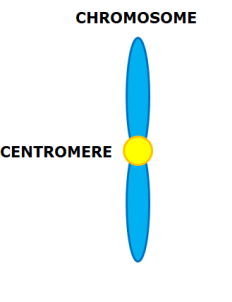
Sister Chromatids
two chromatids attached at a centromere (moves DNA around)
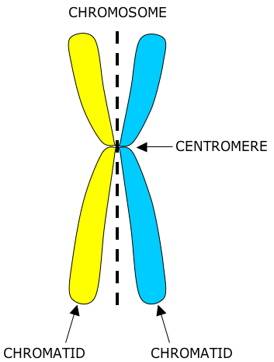
Chromatin
uncoiled DNA; loose, dispersed, immature chromosomes; cell’s DNA is in this form for most of its life
What are the steps of the cell cycle?
interphase, mitosis, and cytokinesis; eukaryotes have very specifically timed steps of cell cycle
Interphase
longest part of cell cycle (90% of cycle); broken down into 3 sub-phases: G1, S, and G2
G1 Phase
first gap/growth phase; first phase of interphase; cell is carrying out routine functions, growing in size, and making new proteins & organelles; nucleus is well-defined & surrounded by nuclear envelope; cell (nerve cells) can spend entire life in this phase
S Phase
aka synthesis; DNA is replicated in preparation for cell division; once cell enters phase, it must continue through rest of cell cycle
G2 Phase
second gap/growth phase; cell prepares for division by making microtubules, proteins & other organelles/molecules that cell may need to divide; cell sure DNA is replicated
G0 Phase
cell does not do cell cycle; cell waits to divide
Mitosis
second phase of cell cycle; asexual reproduction; important step in cell division; division of nucleus to create a new nucleus; process in which two nuclei are formed w/identical set of chromosomes; 4 phases: (PMAT) prophase, metaphase, anaphase, telophase; occurs right before cell division; only occurs in somatic cells; results in two identical daughter cells; creates somatic cells from somatic cells
Cytokinesis
splitting of cytoplasm; process, not a phase; last part of cell cycle; cell splits in half to form two new cells, each w/own nuclei & DNA
Somatic Cells
body cells; every cell in body except for egg/sperm cells; ex. heart cell, liver cell, bone cell; undergoes mitosis
Gametes
sex cells; sperm or egg; undergoes meiosis
Diploid Cells
cell or organism consisting of two sets of chromosomes; has 2 copies of each chromosome; one set comes from mother, other from father; somatic cells are diploid; have homologous chromosomes; human diploid cells have 46 chromosomes (23 from mom, 23 from dad); symbolized as 2n
Haploid Cells
cell or organism conisiting of one set of chromosomes; only has 1 copy of each chromosome; has half the chromosomes; gametes (sex cells) are haploid; doesn't have homologous chromosomes; human haploid cells have 23 chromosomes; symbolized as n
Centrioles
only in animal cells; are made of 9 triplets of microtubules; part of cytoskeleton; plays role in developing spindle fibers formed during mitosis
Spindle Fibers
elongations of the centrioles; forms the mitotic spindle
What is the purpose of mitosis?
growth & repair in eukaryotes; producing offspring in prokaryotes
Prophase
1st step of mitosis; cell prepares for division by breaking down nuclear envelope (membrane); nucleus is visible during this phase; chromosomes condense and are visible; mitotic spindle (spindle fibers) are formed; centrioles move to opposite side of the cell
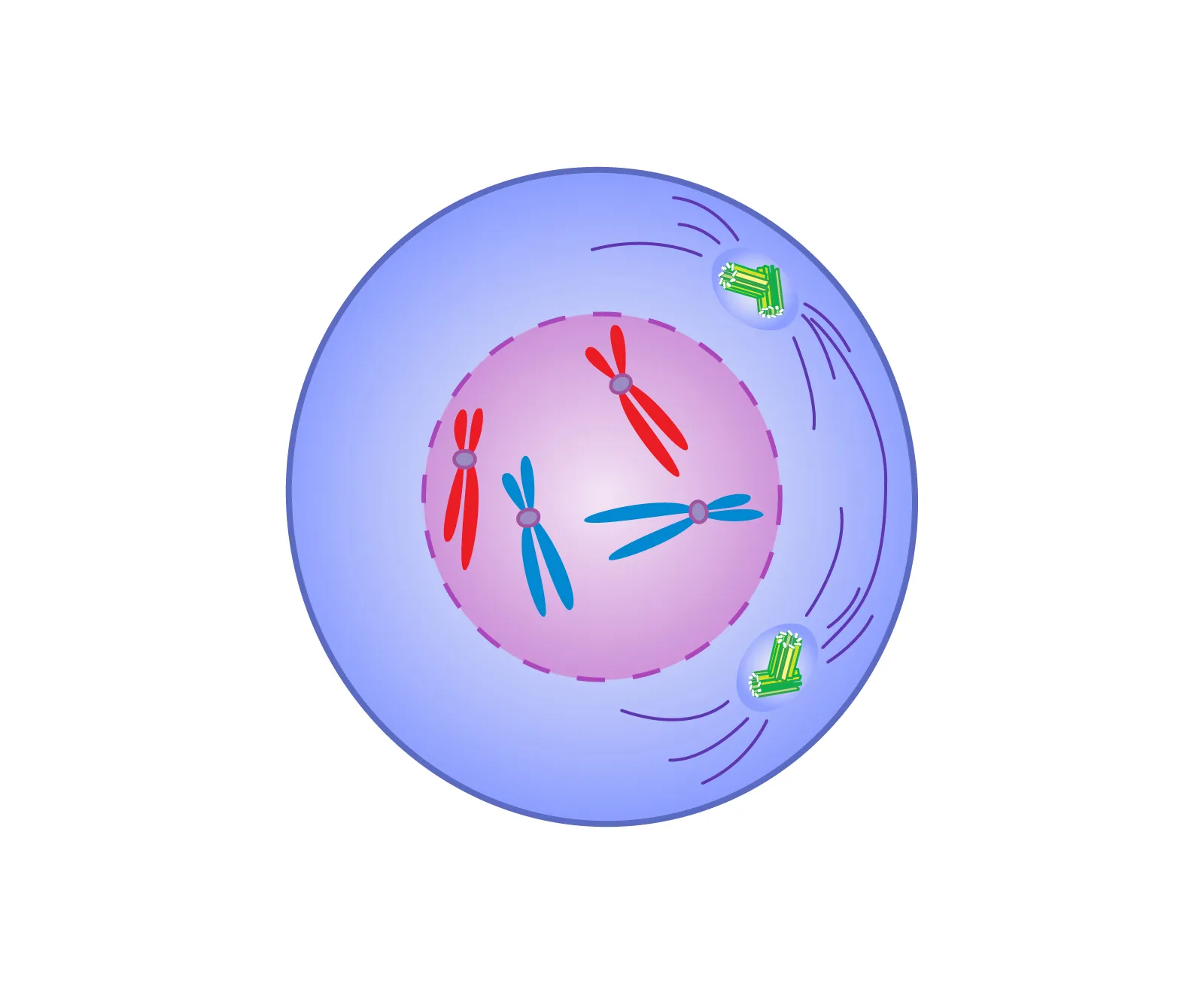
Metaphase
2nd step of mitosis; centrioles are established on opposite ends of the cell; chromosomes line up in the cell’s equator (middle) and attach to spindle fibers; organelles are being divided
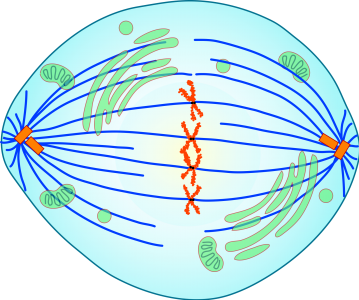
Anaphase
3rd step of mitosis; spindle fibers shorten, pulling chromatids to opposite poles of the cell; centromeres are separated, the chromosomes are no longer attached
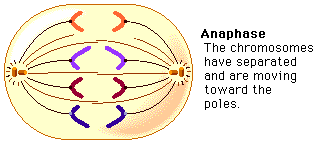
Telophase
4th step of mitosis; nuclear envelope reforms; chromosomes disperse into chromatin; spindle fibers withdraw; in eukaryotes, cell membrane begins to push inward, forming a cleavage furrow; in plant cell, a cell plate is formed between two nuclei, which divides the cell wall and creates two new cells
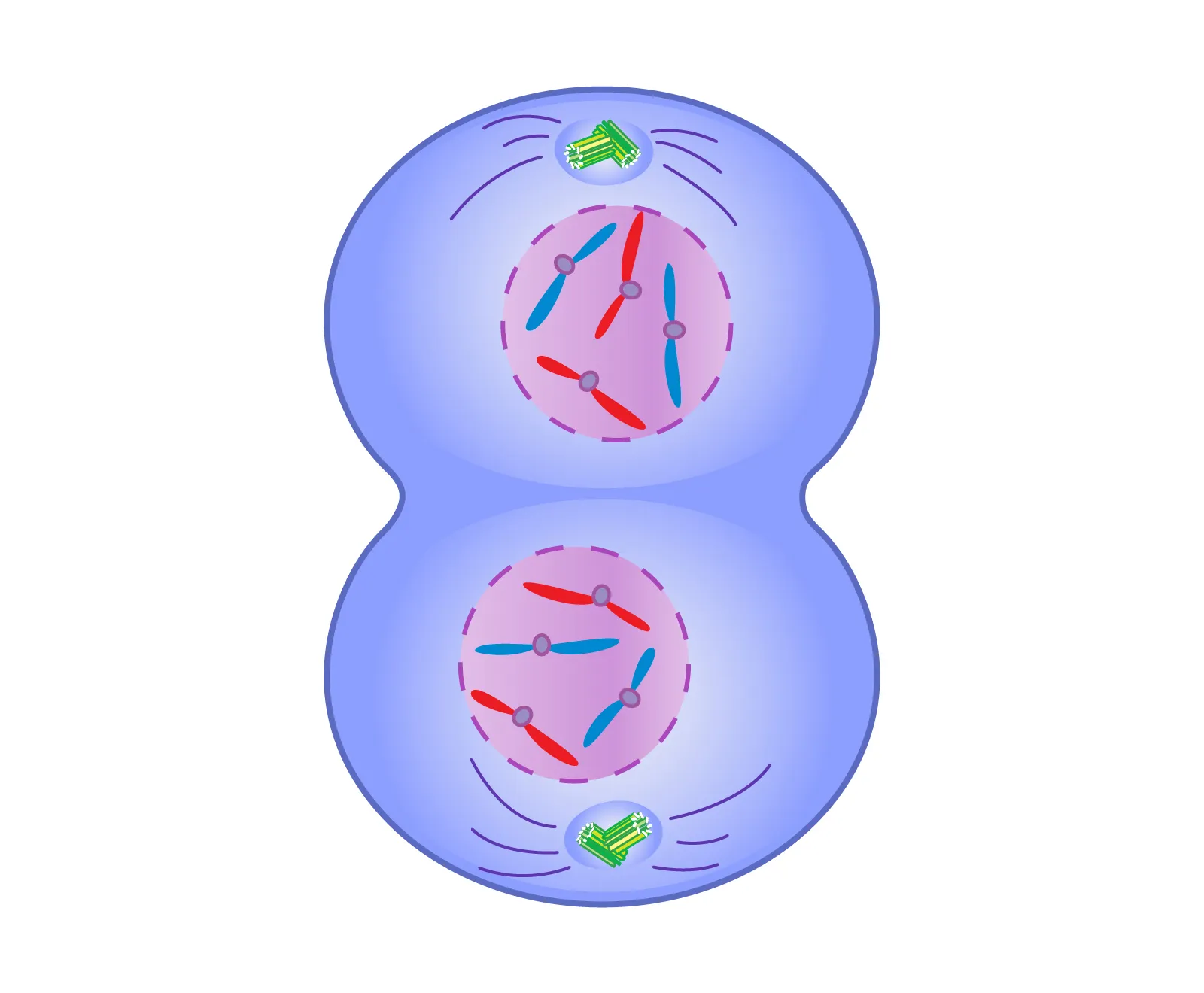
Cytokinesis
cell membrane begins to push inward, creating cleavage furrow; cell splits into two cells by physically dividing
How does mitosis differ between plant and animal cells?
animal cells have centrioles made up of microtubules and help form other microtubule-based structures (spindle fibers); plant cells do not contain centrioles, but they do form a prophase band which is also made up of microtubules; prophase band forms right before prophase and helps create & orient the mitotic spindle
Cell Regulation
cell cycle is very controlled process; regulation of cell cycle is important for healthy cell growth; checkpoints throughout cell cycle (at G1, G2, and metaphase) that ensure cell is growing, replicating DNA, and doing cell function; checkpoints serve as check and balance system for cell; info from inside & outside cell (internal & external factors) help regulate cell cycle
External Factors in Cell Regulation
external physical & chemical signals that help regulate cell cycle; many cells release chemical signals that tell other cells to grow; growth factors are proteins that stimulate cell division (ex. cut skin)
Internal Factors in Cell Regulation
external factors bind to a receptor on cell membrane; this starts a response inside cell that causes it to divide when it gets too large; internal factors include enzymes & proteins that help a cell move through the cell cycle
Apoptosis
programmed cell death; occurs when a cell fails a checkpoint due to being damaged; cells need to die (ex. webbing dissolving between the fingers & toes of fetuses); internal/external signals can start an ordderly process of cell death; cell is broken down and its parts are reused in building other molecules
Cancer
uncontrolled cell division/growth; result of a haywire cell cycle; cancer cells form disorganized clumps called tumors; benign tumors remain clustered & can be removed; malignant tumors metastasize, or break away, and can form more tumors; cancer cells do not carry out necessary function; come form normal cells w/damage to genes involved in cell cycle regulation; substances that are known to cause/lead to cancer are called carcinogens (air pollutants, tobacco smoke, UV rays)
What are the two types of cells?
somatic cells and gametes
Somatic Cells
aka body cells; found in body tissues & organs; DNA is not passed to offspring; ex. nerve cells
Gametes
aka. sex or germ cells; haploid cells; ex. eggs in females, sperm in males; DNA can be passed to offspring
Homologous Chromosomes
aka paired genes; two chromosomes w/the same genetics, but may have different versions of the gene (alleles); one comes from mother, the other from father; are the same size and have the same genes at the same locations
Fertilization
uniting of a sperm and egg cell; n + n = 2n; results in a diploid zygote (fertilized egg)
Meiosis
sexual reproduction; only occurs in gametes; produces gametes; starts w/one diploid somatic cell and ends w/four haploid gametes; reduces # of chromosomes in gamete to half of # in somatic cells; produced cells are genetically difrerent from one another and original cell; 2 phases: meiosis I and meiosis II; cell only goes through interphase once; goes through PMAT twice; cell divides twice
Meiosis I
first stage of meiosis; separates homologous chromosomes (separates mom sets from dad sets); consists of 4 phases: (PMAT I) Prophase I, Metaphase I, Anaphase I, and Telophase I; ends w/2 cells that each have a unique combination of 23 duplicated chromosomes (46 total) coming from both parents
Prophase I
nuclear membrane (envelope) breaks down; centrioles move to opposite sides of cell; spindle fibers form; homologous chromosomes pair up; tetrads form when chromosomes physically cross over; crossing over occurs
Metaphase I
homologous chromosomes line up in the middle of cell; line up in pairs; independent assortment occurs
Which 2 processes create genetic variation during meiosis?
corssing over & independent assortment
Anaphase I
paired homologous chromosomes separate from each other and are pulled to opposite sides of cell by spindle fibers; sister chromatids remain together
Telophase I
nuclear membrane reforms again; spindle fibers dissolve; cell undergoes cytokinesis; creates 2 new haploid cells w/duplicated chromosomes
Meiosis II
second stage of meiosis; separates sister chromatids (not homologous chromosomes; separates mom sets from dad sets); consists of 4 phases: (PMAT I) Prophase I, Metaphase I, Anaphase I, and Telophase I; interphase does not occur again (no chromosomes are replicated); ends in 4 haploid cells w/a combo of chromosomes from both mother & father
Crossing Over
forms tetrads; exchanges genes; when homologous pairs line up opposite each other at the cell’s equator, parts of the chromatids can become twisted around each other; results in a new combo of alleles
Independent Assortment
chromosomes split into daughter cells randomly; homologous pairs line up opposite each other at cell’s equator; random which side of the equator paternal & maternal chromosomes lie; pairs are separated, so one of each homologous pair ends up in the daughter cell; creates large # of possible combos of chromosomes in the daughter cells
Prophase II
cell does not go through interphase again; nuclear membrane breaks down; centrioles move to opposite sides of the cell; spindle fibers form; crossing over doe snot occur
Metaphase II
spindle fibers align chromosomes at the cell equator; chromosmes line up in single file line (not pairs); each chromosome still has one sister chromatid
Anaphase II
sister chromatids are pulled apart by spindle fibers; they move to opposite sides of the cell
Telophase II
nuclear membrane forms again (in some species); spindle fibers dissolve; cell undergoes cytokinesis; forms 4 haploid cells w/un-duplicated chromosomes
Spermatogenesis
meiosis in males; all 4 cell specialize to become sperm cells (in males); sperm only has mitochondria & DNA
Oogenesis
meiosis in females; 1 cell specializes to become an egg cell (females); other 3 become polar bodies that are broken down by cell; occurs bc egg cells are v small so all resources go to 1 cell so it is large enough & has enough organelles
Tetrad
replicated homologous chromosomes that form a total of 4 chromosomes
Nucleotide
monomer of nucleic acids (macromolecule/organic molecule); 3 parts: sugar (deoxyribose, ribose), a phosphate, nitrogenous base (adenine (A), thymine (T, only in DNA), guanine (G), cytosine (C), uracil (U, only in RNA)); link together to form long chains
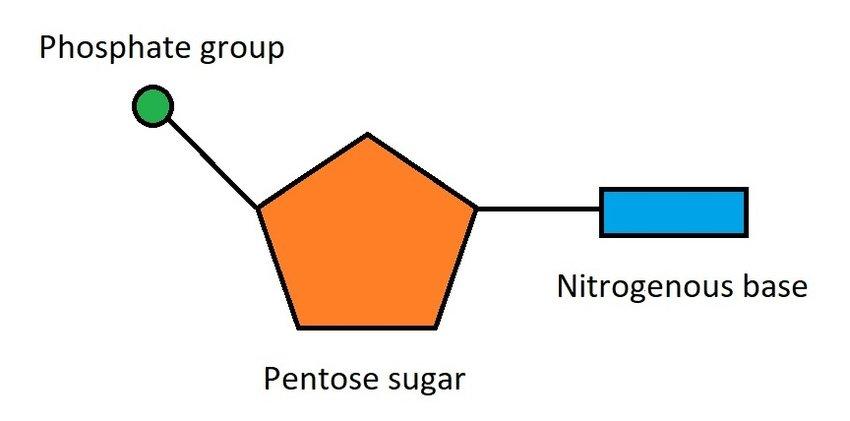
DNA
aka deoxyribonucleic acid; stores, copies, and transmits genetic information using sequences of As, Ts, Cs, and Gs; genetic info is instructions to make an organism’s proteins; DNA like a recipe book for proteins; found in nucleus of eukaryotes (too large to leave nucleus); human DNA is 3 billion nucleotides long
DNA Structure
shaped like a double helix (like a twisted ladder); double-stranded; sugar is deoxyribose; uses the nitrogenous bases A, T, G, and C; has sugar & phosphate backbone; molecules are antiparallel (run parallel in diff directions); has two directions: 3’ → 5’ and 5’ → 3’
RNA
aka ribonucleic acid; helps DNA make proteins; codes for proteins; 3 types: mRNA (messenger RNA), rRNA (ribosomal RNA), and tRNA (transfer RNA); each type has its own job; single stranded; smaller than DNA; can leave nucleus through nuclear pore; sugar is ribose; nitrogenous bases are A, C, G, and U (no thymine); has sugar & phosphate backbone; found anywhere in a cell
What are the rules of base pairing?
nitrogenous bases match up in middle to form two-stranded molecule; bonded w/hydrogen bonds; nitrogen bases pair up in specific way; A pairs w/T (DNA only, 2 hydrogen bonds); C pairs w/G (DNA & RNA, 3 hydrogen bonds); A pairs w/U (RNA only)
Chargaff’s Rule
# of As = # of Ts or Us; # of Cs = # of Gs
Who discovered the structure of DNA?
James Watson & Francis Crick w/help from Maurice Wilkins & Rosalind Franklin
DNA Replication
process of making an identical DNA strand for cell division; uses enzymes helicase, DNA polymerase, and ligase; occurs in nucleus (eukaryotes) and cytoplasm (prokaryotes); occurs during S phase of interphase; semiconservative; (1) helicase “unzips”/separates the two DNA strands; two replication forks make replication bubbles; (2) DNA polymerase adds the nucleotides of the new strands using the old strand as a template; (3) ligase links together pieces of new DNA; creates two molecules of DNA
Transcription
first step of protein synthesis; makes a single strand of mRNA from DNA; uses enzyme RNA polymerase; occurs in nucleus (eukaryotes) and cytoplasm (prokaryotes); (1) DNA unwinds where the desired gene is; (2) RNA polymerase uses DNA as a template to make an mRNA copy; (3) mRNA copy leaves the nucleus through a nuclear pore
Translation
second step of protein synthesis; coverts mRNA to protein; makes a polypeptide from mRNA; occurs in ribosomes; involves mRNA, tRNA, and rRNA; (1) mRNA finds ribosome & binds to it; (2) mRNA codons are read by tRNA; (3) tRNA brings amino acid that matches the codon; (4) amino acids link together using peptide bonds to form a protein
Semiconservative
means each DNA molecule consists of one original strand and one new strand; “conserves” original strand
Helicase
separates DNA strands
DNA Polymerase
adds nucleotides & proofreads DNA; reads parent molecule in 3’ → 5’ direction; new DNA is synthesized in the 5’ → 3’ direction;
Ligase
links new pieces of DNA
Leading Strand
moves continuously toward (with) the replication fork; has continuous replication
Lagging Strand
moves away from (against) the replication fork; has discontinuous replication; jumps backwards to adjust as the replication fork opens; Okazaki fragments are short segments of new DNA on the lagging strand
What is the central dogma of protein synthesis?
DNA → RNA → proteins
What are the two steps of protein synthesis?
translation and transcription
Codon
sequence of 3 nucleotides that code for an amino acid; like words of genetic code; need to translate all words to get message (protein)
mRNA
messenger RNA; carries DNA message as codons
rRNA
ribosomal RNA; makes up ribosomes
tRNA
transfer RNA; matches anti-codon to mRNA codon to bring the correct amino acid
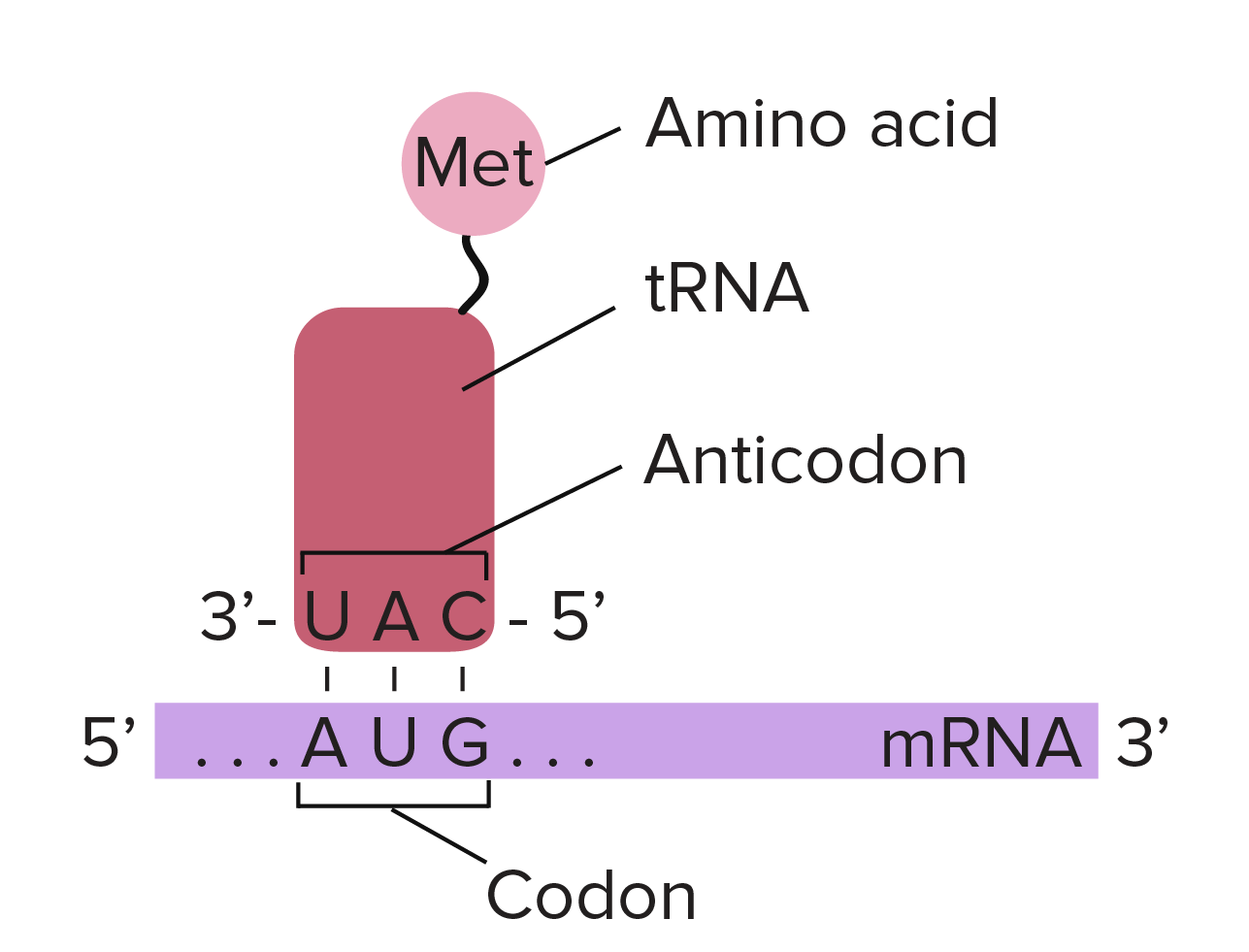
Mutations
a mistake in DNA/RNA sequence (ex. A paired w/G); cells make mistakes that have a range of effects; change in organism’s nucleic acids; musation must occur in gamete to be passed on to offspring; 2 main types: gene mutations (affect genetics) and chromosomal mutations (affect heredity); 2 ways it can take form: point mutation or framshift mutation (insertion or deletion)
What determines if a mutation has an effect?
whether or not a different protein is build; if mutation build the same proteins, mutation is okay/beneficial; if mutation builds a different protein, it is bad; some genes are junk genes, so mutations have no effect
Point Mutation
aka. substitution; one nucleotide is put in place of the correct nucleotide (ex. A in place of G); happens at only one point; only affects one nucleotide; has highest likelihood of coding for same proteins; mistake is usually caught & fixed by DNA polymerase; if not, substitution MAY permanently change an organism’s DNA; ex. sickle cell anemia
Frameshift Mutation
involves insertion or deletion of a nucleotide in a DNA sequence; shifts entire sequence by one or more nucleotides; dangerous; tends to have a bigger impact; ex. cystic fibrosis